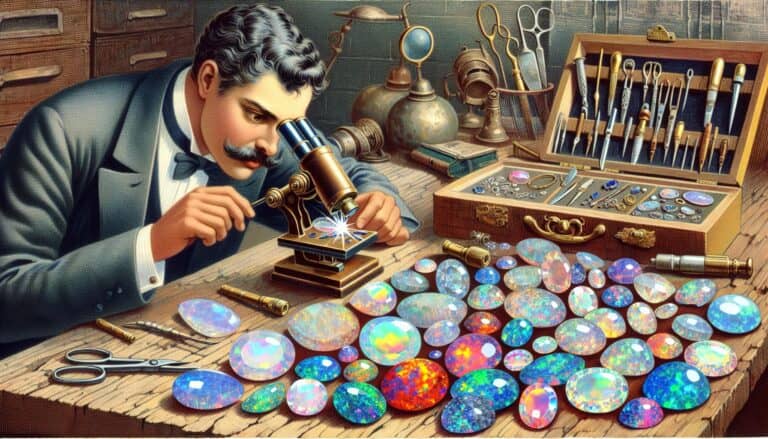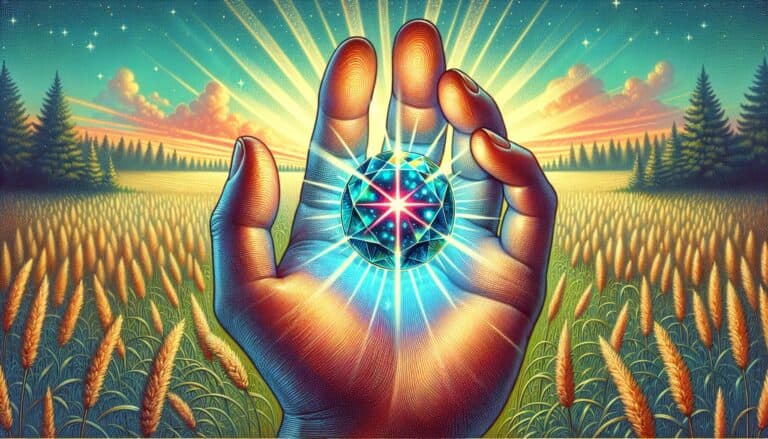Ever wondered what gives moonstone its ethereal glow?
Known for its mesmerizing sheen, moonstone has captivated jewelry lovers for centuries. But beyond its beauty, you’re probably curious about its value.
The worth of moonstone varies widely, influenced by factors like size, quality, and rarity. Whether you’re a collector or simply eyeing that perfect piece of moonstone jewelry, understanding its value is key.
Let’s dive into the shimmering world of moonstone and discover what your piece might be worth.
Moonstone’s value is determined by its adularescence, color, clarity, cut, and carat size. The most valued are blue moonstones with strong sheen and transparency. Rarity, cut quality, and market demand also influence its price. High-quality moonstones, especially those with exceptional adularescence, command premium prices.
What Is Moonstone?
Moonstone is a captivating gemstone celebrated for its unearthly sheen, which shimmers under the surface of its crystalline body, known as adularescence. This phenomenon occurs due to the interplay of light with overlapping layers of orthoclase and albite, which are minerals that constitute moonstone.
Traditionally associated with the moon due to its glow that recalls lunar light, moonstone comes in a variety of colors ranging from blue and peach to grey and white. The most prized moonstones exhibit a blue sheen and a high degree of transparency.
As a member of the feldspar group, moonstone has a Mohs hardness rating of 6 to 6.5, making it a relatively soft gem compared to others like diamonds or sapphires. You need to handle your moonstone jewelry with care to prevent scratching or damage.
In the cultural realm, moonstone carries significant historical baggage. It has been revered as a sacred stone in many civilizations and is often associated with love, fertility, and intuition. Its mystical attributes and unique appearance have kept moonstone in high demand in the realms of jewelry and personal collections.
Whether you’re drawn to moonstone for its historical significance or simply its aesthetic allure, understanding its characteristics ensures you can appreciate this gemstone’s full value. Remember, it’s not just the visual aspects that determine moonstone’s worth; its historical context and cultural impact are also vitally important.
Moonstone Prices: Factors That Affect Value

Moonstones captivate collectors and jewelry enthusiasts alike, but before you rush to purchase one, you’ll want to understand what drives their value. There’s much more than meets the eye when it comes to pricing this enigmatic gem. The factors that can significantly impact moonstone prices boil down to color, clarity, cut quality, market demand, and availability.
Color, Clarity, and Cut Quality
When assessing moonstones, color is perhaps the most impactful on its worth. Blue and rainbow moonstones are especially sought after for their unique adularescence—an ethereal, floating light or sheen. The more pronounced and vivid this phenomenon, the higher the stone’s value.
Clarity is another crucial component. Moonstones should be free from inclusions to be considered top quality. Inclusions can detract from the stone’s captivating luminosity, thus decreasing its value. However, sometimes, certain inclusions can create an intriguing effect that may increase the stone’s appeal to particular buyers.
The cut of the moonstone also plays a vital role in its aesthetic and, consequently, its price. A well-executed cut can enhance the stone’s adularescence, making it more alluring and valuable. Artisans who can skillfully amplify this natural feature with a perfect cut are well-respected, and their work get higher prices.
Market Demand and Availability
Moonstone’s value is also at the mercy of market demand—the dance of supply and demand that always plays a central role in pricing gemstones. Moonstones that exhibit exceptional qualities are in high demand amongst collectors and jewelry designers, driving up prices.
Conversely, moonstone’s availability affects its cost as well. While certain types of moonstone are relatively abundant, others are exceedingly rare. For instance, a high-quality blue moonstone can be significantly more expensive due to its scarcity. Geological factors and mining conditions contribute to the rarity of specific moonstone varieties and, as a result, determine their presence on the market.
As you delve into the world of moonstones, be mindful that their value doesn’t only depend on their innate beauty. It’s important to consider their unique characteristics and the market dynamics to truly understand their worth. Whether you’re investing in jewelry or adding to a collection, paying attention to these details will guide your appreciation of moonstone’s true value.
Understanding Moonstone: A Rare Gem

The Rarity of Moonstone
You may not realize it but moonstone stands out among gemstones due to its unique qualities and limited availability. Unlike more common gems, such as quartz or amethyst, finding a piece of moonstone is akin to uncovering a hidden treasure.
- Adularescence: This quintessential characteristic, a ghostly glow that seems to move within the stone, is present only in finer quality moonstones.
- Rare Colors: The most valuable moonstones exhibit an entrancing blue sheen. Other sought-after varieties, like the rainbow moonstone, boast a multicolored shimmer.
The supply of high-quality moonstone is limited, which further drives its rarity and desirability. For instance, the historic mining locations in Sri Lanka are known sources of some of the finest specimens available and yet, the yields are relatively small. Other sources include India, Madagascar, and Tanzania, each offering moonstones with distinctive qualities that contribute to their uncommon status in the gem world.
Origins and Characteristics
Moonstone’s origins hold key insights into its value. Typically, you’ll find this gem in igneous and metamorphic rocks. It’s primarily composed of two feldspar species that mix and then solidify, allowing light to scatter in captivating ways.
Moonstones come in a variety of colors, ranging from delicate shades of peach and cream to stunning blues and grays. The color can significantly affect its value. The characteristic schiller, that is, the moonstone’s light-reflecting feature, is due to its unique internal structure. This gives each piece a special property known as adularescence – the soft glow or luster that seems to emanate from within the gem.
| Color | Commonality | Adularescence |
|---|---|---|
| Peach and Cream | More Common | Warm Glow |
| Blue and Gray | Less Common | Pronounced Sheen |
Moonstone’s hardness is another aspect to consider; on the Mohs scale, it ranges from 6 to 6.5, making it less durable than many other gemstones. This means moonstone jewelry needs to be worn and cared for with a degree of caution to prevent scratching or damage.
As you delve deeper into the traits and sources of moonstone, you’ll appreciate the factors that make it as exceptional as it is. Each piece tells a story that starts from its geological formation, transcending through time to become a cherished possession. Admiring your moonstone, you’ll understand why its rarity is not just about numbers but the very essence that defines its allure and mystique.
Moonstone Grading and Valuation
When you’re in the market for moonstones, understanding their value is key. Moonstone grading and valuation involve several factors that directly impact cost.
The Grading System for Moonstone
Moonstones aren’t graded like diamonds; there’s no universally accepted system. However, certain attributes significantly sway their value.
- Adularescence: This phenomenon is the cornerstone of moonstone quality. The more pronounced and vibrant the blue sheen, the higher the stone’s worth.
- Clarity: Moonstones should be free from inclusions, which can detract from their desired translucent to opaque appearance. Clearer stones fetch higher prices.
- Color: Pure blue moonstones are especially sought after and command premium pricing. However, rainbow moonstones with a variety of colors reflected also have a strong market presence.
- Cut: A moonstone’s cut can either highlight its best features or detract from them. Skilled artisans are essential in crafting a stone that maximizes its natural beauty.
- Carat Weight: Larger moonstones are rare, and as the carat weight increases, so does the value.
| Attribute | Effect on Value |
|---|---|
| Adularescence | Higher value with stronger glow |
| Clarity | Clearer stones are more valued |
| Color | Pure blue and rainbow are sought after |
| Cut | Expert cut can increase value |
| Carat Weight | Larger stones are more valuable |
Keep these factors in mind as you hunt for the perfect moonstone. Remember, beauty is in the eye of the beholder, and ultimately, it’s your personal preference that matters the most.
Certification and Appraisal
Due to the lack of a standardized grading system, certification and appraisal for moonstones come into play for authentication and valuation purposes.
- Certification: A certificate from a reputable gem lab detailing a moonstone’s characteristics can provide assurance of its quality and authenticity. This can be especially important for rarer stones.
- Appraisal: A professional appraisal involves a thorough assessment of the moonstone by a certified gemologist. They’ll consider the stone’s overall quality, market demand, and current trends to estimate its value.
When buying or selling moonstone jewelry, always look for a certificate or appraisal to ensure you’re getting a fair deal. Secure transactions are the backbone of confidently adding to your collection or investing in moonstone pieces.
Checking for these documents can not only inform you about the stone you’re dealing with, but it also provides a safety net for your investment. Keep your eyes peeled for moonstones with documentation to back their worth; it’s a small step that could make a significant difference in your purchase.
Current Market Trends in Moonstone Pricing
As you dive into the world of gemstone investments, keeping a close eye on current market trends is vital for understanding moonstone pricing. Moonstone’s value has seen a steady increase over the years, influenced by fashion trends and its growing popularity in mindfulness and spirituality circles.
The market today shows a heightened demand for high-quality specimens, particularly those exhibiting exceptional adularescence. Moonstones showcasing a blue or rainbow sheen, free of inclusions, warrant higher prices. These coveted characteristics align with the preferences of high-end jewelers and collectors alike, who are willing to pay top dollar for prime pieces.
Fashion trends also play a significant role in moonstone pricing. Jewelry featuring moonstones set in rose gold or paired with other colored gemstones may fetch higher prices due to their contemporary appeal. As bohemian and vintage styles continue to influence the market, so too does the desire for unique moonstone pieces that embody these aesthetics.
Investment potential has become a buzzword in moonstone markets, with investors and collectors viewing high-grade moonstones as a more affordable alternative to other precious stones. Prices fluctuate based on rarity and quality, but with the right timing, you could secure moonstone gems or jewelry pieces that appreciate in value.
It’s crucial to stay informed about the origins of the moonstones in the market, as source countries can affect their valuation. For instance, moonstones from Sri Lanka, known for their high quality, are often more valuable than those from other locations. Moreover, as certain mines deplete and new sources are discovered, these geopolitical factors could significantly impact future pricing trends.
In the table below, you’ll find an overview of how different qualities may affect moonstone prices:
| Quality Attribute | Price Range Impact |
|---|---|
| Adularescence | High Prices |
| Clarity | Moderate to High |
| Color (Blue/Rainbow) | Premium Prices |
| Cut and Finish | Varied |
| Carat Weight | Scales with Size |
Remember, while market trends provide a snapshot of current values, prices for moonstones are not set in stone. They can shift due to a multitude of factors, such as geopolitical shifts, global economic conditions, and even changing fashion trends. Stay attuned to the industry to make the most informed purchasing decisions.
The Most Expensive Moonstone
When diving into the world of moonstone, you’ll find that the most expensive pieces are truly a marvel. Blue moonstones with high transparency and a strong, visible adularescence command the highest prices. Exceptional specimens can fetch thousands of dollars. It’s not just the size but the stone’s quality and rarity that determine its value.
Historically, the largest and finest moonstones have been discovered in Sri Lanka. The island’s gemstones are famed for their alluring, watery blue sheen. Additionally, high-quality specimens from India and Madagascar have also made their mark on the luxury market.
Prices for top-notch moonstones from these sources can reach startling amounts. Let’s take a closer look at what sets the most expensive moonstones apart:
- Carat Weight: Larger stones naturally tend to be more valuable, though size alone won’t dictate price without considering quality.
- Clarity: Moonstones must be clear or only include minimal inclusions.
- Cut: A well-executed cut can enhance the stone’s adularescence, and skilled lapidaries who can achieve this are highly sought after.
- Color and Adularescence: The most prized moonstones exhibit a clear blue or rainbow-like sheen that appears to float on the stone’s surface.
To give you an example of pricing at the pinnacle of the market, in recent years, an exquisite 30-carat blue moonstone ring was auctioned for over $50,000.
The allure of such precious moonstones extends beyond mere adornment—they often embody the zenith of a collector’s pursuit for perfection. While some investors may hesitate at the steep price tags, those who understand the gemstone’s unique qualities recognize the potential for these stones to appreciate in value.
By staying updated with the market and selecting high-quality pieces, you can make both a luxurious and potentially wise investment in moonstones. Keep in mind that the authenticity of each gemstone contributes to its value. Always ensure you’re purchasing certified moonstones from reputable dealers.
Buying Moonstone: Tips and Recommendations
Where to Purchase High-Quality Moonstone
When looking to purchase high-quality moonstone, your options include specialized gemstone stores, online retailers, and gem exhibitions. Specialized gemstone stores are ideal for hands-on inspection of the stone’s quality. Here, you can see the moonstone’s adularescence and transparency up close. Online retailers offer a broader selection and often, more competitive prices. To ensure you’re getting top-quality moonstones online, only shop from reputable websites with clear, high-resolution images of their inventory.
Gem exhibitions, on the other hand, present the opportunity to meet directly with gemstone miners and wholesalers. These events can offer unique pieces at wholesale prices. Keep in mind that the most reputable exhibitions will attract vendors who sell only the best-quality gems.
- Establish a trusted dealer or retailer with a proven track record
- Request clear, detailed images if purchasing online
- Check for good reviews and customer feedback
- Attend reputable gem exhibitions for direct purchases
Ensuring Authenticity and Value
To guarantee you’re getting your money’s worth, insist on certification for any moonstone you consider purchasing. Reputable dealers should provide a certificate that verifies the stone’s authenticity. Additionally, an appraisal can affirm its value, especially if you’re seeing it as a future investment. The Gemological Institute of America (GIA) is one of the most respected organizations for gemstone certification.
Here are key steps to ensure authenticity and protect your investment:
- Always ask for a certification from a recognized gemological lab
- An appraisal by an independent gemologist can add another layer of assurance
- Familiarize yourself with the key quality indicators of moonstone: adularescence, clarity, color, cut, and carat
Remember that a genuine moonstone’s worth isn’t just in its exquisite beauty; it’s also in the peace of mind that comes from knowing you’ve made a secure and valuable purchase. With these tips and recommendations, you’re better equipped to find high-quality moonstones that are as authentic as they are enchanting.
Conclusion: Buying & Selling Moonstone
Understanding the true worth of moonstone boils down to its unique characteristics and your due diligence in the buying process.
Remember, the allure of moonstone lies in its mesmerizing play of light and the intricacies of its natural features. When you’re on the hunt for this gem, prioritize its adularescence, clarity, color, cut, and carat weight to gauge its value. Don’t overlook the significance of certification and appraisal—they’re your assurance of the stone’s authenticity and quality. Whether you’re browsing through specialized gemstone stores, vetting online retailers, or exploring gem exhibitions, always seek out trusted dealers and insist on comprehensive documentation.
By keeping these insights in mind, you’ll be well-equipped to discern the true value of moonstone and make a purchase that’s as wise as it is enchanting.




![ND Rockhounding Sites in [year]: Treasures & Finds](https://observationhobbies.com/wp-content/uploads/2024/01/NXhSmnQX-d6GEwx7lYbig-768x439.jpg)
![Wyoming Rockhounding Sites in [year]: Jade & More Gems](https://observationhobbies.com/wp-content/uploads/2024/01/8Vd9NCMeQ44v5fUz8GV7r-768x439.jpg)

![Tennessee Rockhounding Sites in [year]: Gems & Fossils](https://observationhobbies.com/wp-content/uploads/2024/01/EFGCim-a-H4l1G9wAyX6B-768x439.jpg)